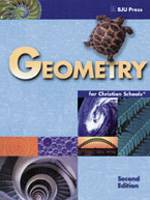BJU Press's Geometry text is Euclidean in its approach. Topic coverage is similar to other challenging geometry courses that include an introduction to trigonometry. It also has one optional section on spherical, non-Euclidean, geometry you can use if your teen has time and inclination.
The course begins with a presentation of set theory, definitions, postulates, and theorems. It builds concepts in a logical progression, using formal proofs that are taught in the fifth unit. Proofs are introduced with a few lessons in logic that make it easier to understand how proofs work.
Three options for using the text are presented in the teacher's edition: intuitive course, standard course, and rigorous course. Exercises within each section are grouped into 3 sections with increasing levels of difficulty. The number of proofs required varies from minimal to extensive depending upon which track you select. Trigonometry is omitted in the intuitive track, optional in the standard, and required in the rigorous.
Lessons are designed to be presented from the two-volume teacher's edition, although students should be able to get through many of the lessons without such presentations. Each chapter includes biographical and historical information relating to geometry, analytic geometry sections making connections to algebra, "Geometry and Scripture" sections that correlate biblical principles with math, practical application examples, and chapter review. Cumulative reviews cover material covered up to that point.
Students learn to make constructions with straightedge and compass. In an improvement over the first editions, connections are made to geometric principles that each construction demonstrates.
The teacher's edition contains reduced pictures of student pages, motivational ideas, expanded concept explanation, strategies for presentation, tips for difficult problems, and answers to all questions in the student text.
The Student Activities book provides more practice problems, work with calculators and constructions, enrichment topics that enhance conceptual understanding, and more historical connections and biblical applications. There is a separate teacher's edition for this book. The Test Packet includes quizzes, and there is a separate answer key for these.
This course should be practical for homeschoolers to use.
[Note: there are no significant changes I could find from the second edition which I originally reviewed to the new third edition. Sandi French tells me: "I teach classes for homeschoolers with these. The difference is primarily in the T.E. The copies of student pages in the T.E. are now color instead of B&W. This is nice but not essential--it is good to be able to see 'that blue box you see on the bottom of page 37' instead of everything being gray! The only change to student book is that they incorporated the Student Activities Book activities into the regular textbook in an additional section at the end of each chapter. The T.E. now includes those, with answers as well. Other than those two things, all assignments still match--same problems on same pages. I can assign to students using EITHER edition, and they all end up doing the same work. If I decide to assign Student Activity problems, I just do it separately (type them up) so that all have them as a handout.]









